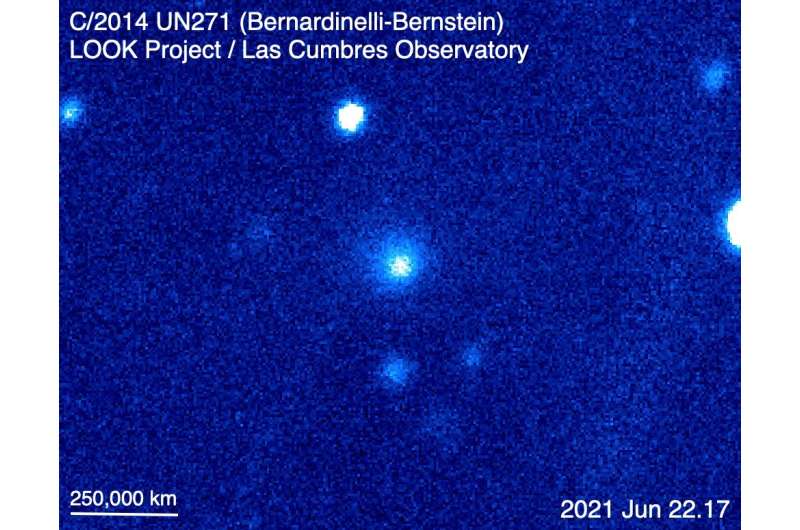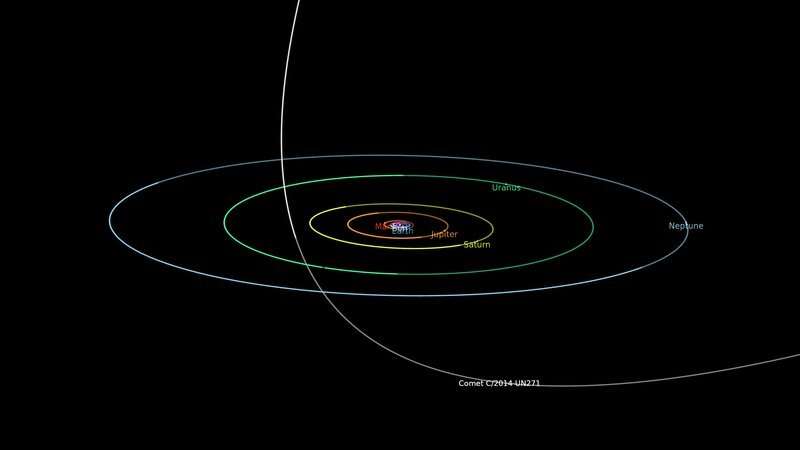At the time of the announcement, there was no indication that this was an active world. Anticipation was immediately high among astronomers. C/2014 UN271 was inbound from the cold outer reaches of the solar system, so rapid imaging was needed to find out: when would the big new-found world start to show a comet's tail?
Las Cumbres Observatory was quickly able to determine whether the object had become an active comet in the three years since it was first seen by the Dark Energy Survey. "Since the new object was far in the south and quite faint, we knew there wouldn't be many other telescopes that could observe it," says Dr. Tim Lister, Staff Scientist at Las Cumbres Observatory (LCO). "Fortunately LCO has a network of robotic telescopes across the world, particularly in the Southern Hemisphere, and we were able to quickly get images from the LCO telescopes in South Africa,"' explained Tim Lister.
The images from one of LCO's 1-meter telescopes hosted at the South African Astronomical Observatory, came in around 9pm PDT on Monday night June 22. Astronomers in New Zealand who are members of the LCO Outbursting Objects Key (LOOK) Project were the first to notice the new comet.
"Since we're a team based all around the world, it just happened that it was my afternoon, while the other folks were asleep. The first image had the comet obscured by a satellite streak and my heart sank. But then the others were clear enough and gosh: there it was, definitely a beautiful little fuzzy dot, not at all crisp like its neighboring stars," said Dr. Michele Bannister at New Zealand's University of Canterbury. Analysis of the LCO images showed a fuzzy coma around the object, indicating that it was active and was indeed a comet, even though it is still out at a remarkable distance of more than 1,800,000,000 miles, more than double Saturn's distance from the sun.

The comet is estimated to be over 100km in diameter, which is more than three times the size of the next biggest comet nucleus we know, Comet Hale-Bopp, which was discovered in 1995. This comet is not expected to become naked-eye bright: it will remain a telescopic object because its closest distance to the sun will still be beyond Saturn. Since Comet C/2014 UN271 was discovered so far out, astronomers will have over a decade to study it. It will reach its closest approach to the sun in January of 2031. A recent article in the New York Times about the comet details its predicted travel.
Thus Tim Lister and the other astronomers of the LOOK Project will have plenty of time to use the telescopes of Las Cumbres Observatory to study C/2014 UN271. The LOOK Project is continuing to observe the behavior of a large number of comets and how their activity evolves as they come closer towards the sun. The scientists are also using the rapid response capability of LCO to get observations very quickly when a comet goes into an outburst.
"There are now a large number of surveys, such as the Zwicky Transient Facility and the upcoming Vera C. Rubin Observatory, that are monitoring parts of the sky every night. These surveys can provide alerts if one of the comets changes brightness suddenly and then we can trigger the robotic telescopes of LCO to get us more detailed data and a longer look at the changing comet while the survey moves onto other areas of the sky," explains Tim Lister. "The robotic telescopes and sophisticated software of LCO allow us to get images of a new event within 15 minutes of an alert. This lets us really study these outbursts as they evolve."



